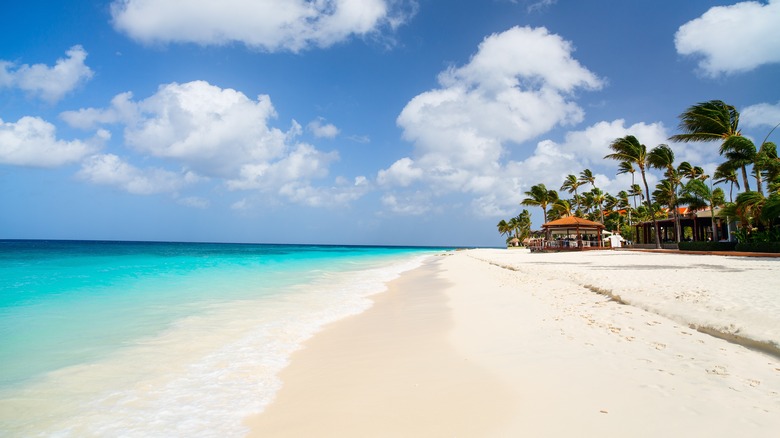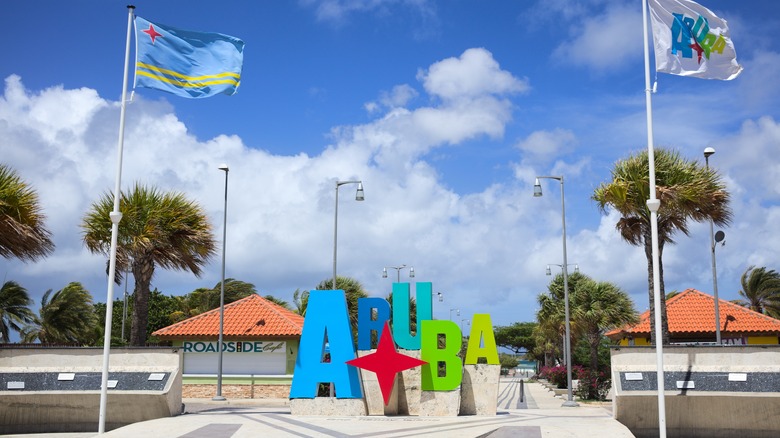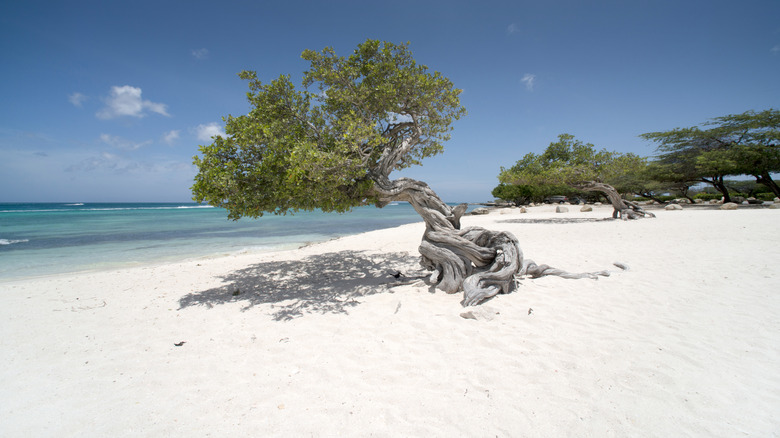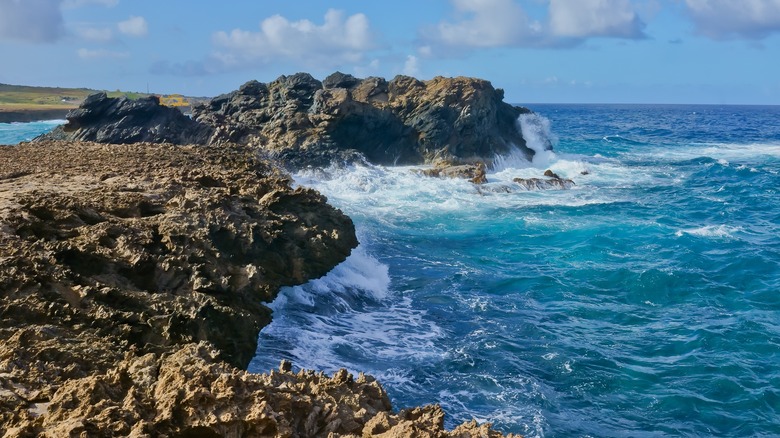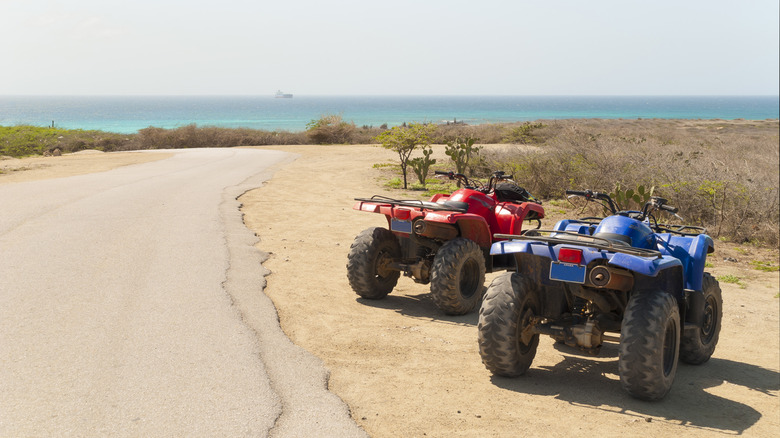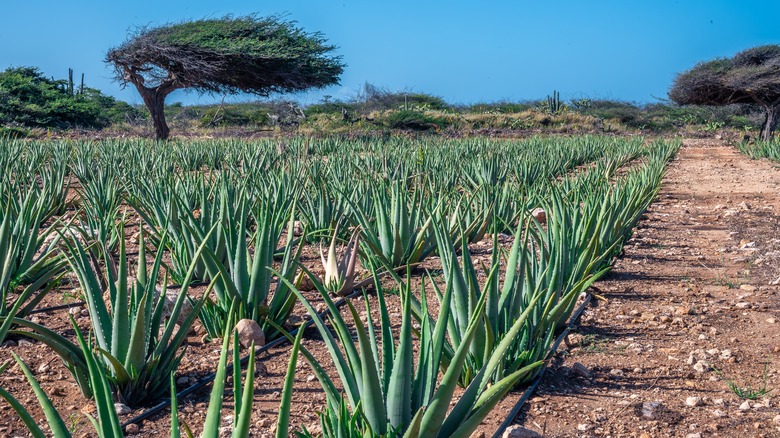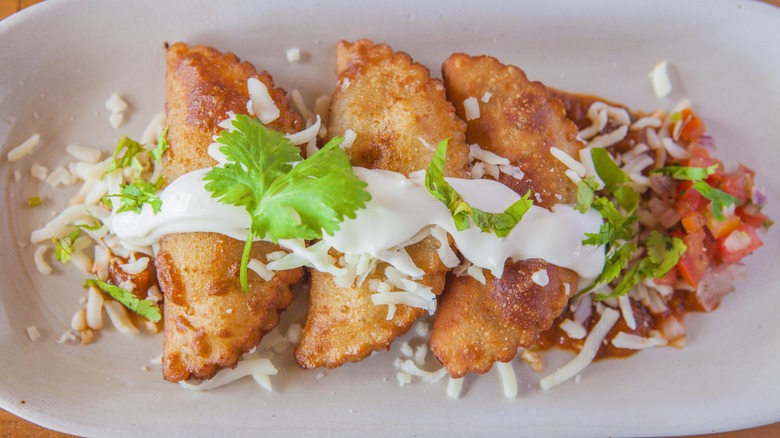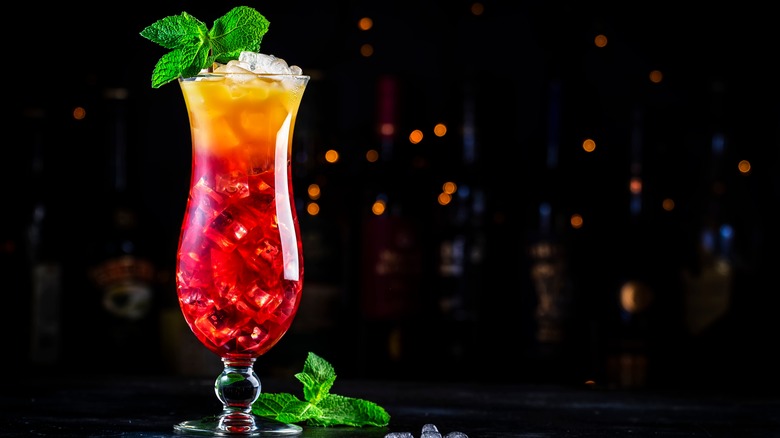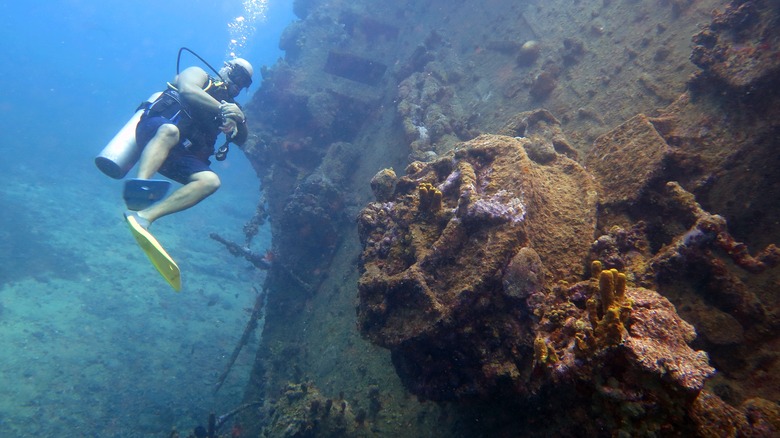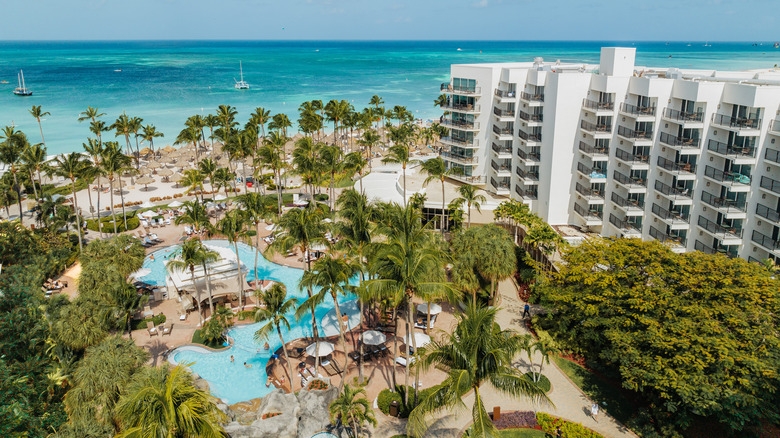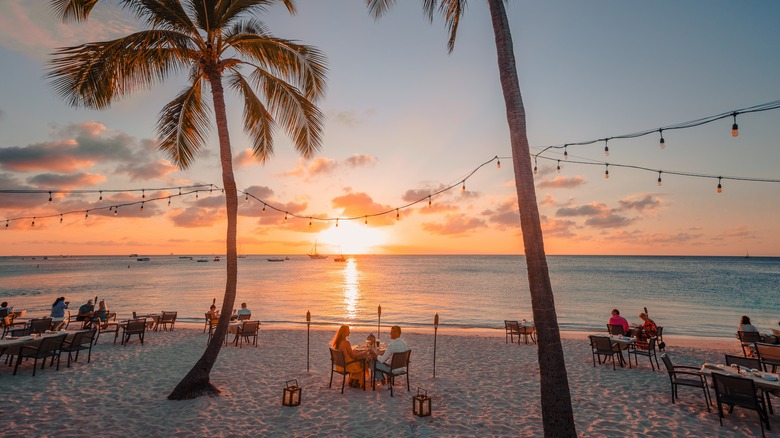The Ultimate Guide For Planning The Perfect Trip To Aruba
One of the most popular of the Caribbean islands, Aruba is the westernmost island of what people call the "ABC Islands." The term ABC Islands refers to Aruba, Bonaire, and Curacao. The three Islands all have ties to the Kingdom of the Netherlands. These islands are safe from hurricanes, so if you're looking to go to a Caribbean island, you won't have to worry about the fear of hurricanes at this Caribbean island. Of course, any time of year is a good time to go to Aruba, as it's a beautiful island with plenty to offer and generally good weather year-round. There are beautiful white sand beaches, turquoise water, good food, and adventurous activities throughout the island.
Aruba's moniker is One Happy Island, and it's easy to see why once you come. Whether you're looking for an active holiday or a chill retreat, Aruba delivers. To help you plan the perfect trip to Aruba, here is a guide to all you need to know before you go, from logistics like currency and language to the best things to do on the island and where to stay and eat.
What to know before you go
Aruba is an easy trip if you live in the eastern half of the United States. The international airport (AUA) is located in Oranjestad. There are nonstop flights to Aruba from many U.S. cities, including New York, Boston, Dallas, and Chicago. If you're flying back to the United States, there is U.S. pre-clearance at the Aruba airport, so you will not need to clear immigration and customs stateside. Plus, visas are not required for U.S. citizens and permanent residents to visit Aruba.
The official language of Aruba is Dutch and Papiamento, the local Creole language. Many Arubans, especially those working in the tourism and hospitality industry, also speak English quite well, so the language barrier is typically not an issue for tourists visiting the island.
The currency of Aruba is called the florin, and at the time of writing, 1 Aruban florin is equivalent to U.S. $0.56. If you're coming from the United States, though, there's no need to exchange any currency. The U.S. dollar is widely accepted all over the island and a lot of restaurants and shops list their prices in dollars.
Getting around the island without a rental car is fairly easy, especially if you're staying in one of the major areas. There is a public bus that has regular service between tourist areas like Oranjestad, Palm Beach, and Eagle Beach. Since the island isn't that big, a taxi is also an easy and relatively inexpensive way to get places. Just keep in mind that generally, taxis are cash only.
The rainy season in Aruba is from November to January, but even then the rain tends to come in short spurts, so visitors can still easily enjoy their day outside.
What to know about the beaches of Aruba
One of the great things about Aruba is that there are many beautiful beaches that are free to the public and usually have free parking, as well. Eagle Beach is certainly the most popular of Aruba's beaches, with its picturesque fofoti trees. The beach is frequently named one of the best beaches in the world thanks to its pristine, soft white sand. Eagle Beach and Palm Beach have resorts and restaurants along them.
Technically, all the beaches on the main island of Aruba are public beaches, so you don't need to stay at a beachfront hotel to enjoy Aruba's beaches. On the other hand, Aruba's beach resorts have facilities that make the experience akin to a private beach. The hotel beach areas are great if you're looking for a beach that is already set up with beach chairs and umbrellas. Plus, at a hotel beach, you can order food and drinks, because what's better than a pina colada on a sunny day?
On the other hand, if you just want to relax on a quiet beach without the need for facilities and food service, there are other less-visited beaches in Aruba as well. Beaches like Dos Playa Beach and Boca Grandi offer a more tranquil experience, while Baby Beach is known for being the most family-friendly in the Caribbean. For a completely different beach experience, head to Aruba's only black sand beach, Blackstone Beach. Blackstone Beach is rocky and waves are too strong for safe swimming, but it's a cool beach to see if you happen to be on this side of the island.
The two sides of Aruba
Aruba's sandy beaches are located on the western side of the island. The western side is also where the capital, Oranjestad, is located along with the resorts and restaurants. The west side is likely the image you have in mind of Aruba, with its clear and calm turquoise water and white sand beaches. The other side of Aruba, though, offers the complete opposite landscape.
The eastern side of Aruba is rocky, with strong winds and waves, which make for a different kind of natural beauty. The area is also rugged and undeveloped. The major attraction on the east side is Arikok National Park. The national park actually encompasses almost 20 percent of the island and is home to deserts and caves, including one where you can find ancient drawings from early inhabitants of the island. There are also natural pools and rocky but scenic bays. There was once a large natural bridge here which collapsed in 2005, but a smaller natural bridge still stands next to where the former bridge was.
On the way to the eastern coast, you may also pass a desert landscape with cactus and dunes. In the middle of the island lies the Casibari rock formation, a rock formation made of tonalite (a plutonic rock) that seemed to have been gathered and piled at this place, although it's unclear why. For an island that is only 20 miles long and six miles wide, Aruba sure has quite the geological diversity.
The adventurous side of Aruba
Aruba isn't just about lying around on the sand. There are many adventurous activities you can do on the island. One of the most popular adventurous things to do in Aruba is to go off-roading. There are many different off-roading tours in Aruba. In fact, this is the best way to explore Arikok National Park. You can book a jeep tour where the tour guide will drive your group around. You can also drive your own ATV or sand buggy on a guided tour. There's also an option to do an off-road e-bike tour or go mountain biking (there are surprisingly over 200 miles of mountain biking trails on the island).
If you're a rock climber, there are a few routes you can explore on your own on the island. Alternatively, how about getting your thrills on or under the water? Sea scooters can take you snorkeling with speed or you can explore the coastline via an ocean kayak instead. Jetski rentals are available along the west coast beaches of the island. Some spots along the coastline also make for some fun cliff jumping.
For adventures on the water, there are some great spots for surfing and kite surfing in Aruba, like Hadicurari Beach which hosts the largest windsurfing competition in the Caribbean each June, the Aruba Hi-Winds.
Relaxing things to do in Aruba
There are many ways to relax on this Caribbean island: lay on the beach, and take a dip in the warm ocean water. Catamaran and sailing cruises are aplenty in Aruba and it's a great way to relax while taking in the sun and ocean views, perhaps with a cocktail in hand.
A unique thing you can do in Aruba is to visit the aloe factory. Royal Aruba Aloe was started in 1890 and it was one of the first companies in the world to grow and process aloe. The Dutch introduced the aloe vera plant to Aruba in 1840 and the plant happened to grow quite well on the island. The plant became Aruba's first major export and is now featured on the country's coat of arms. The company offers free factory tours or you can also book an appointment to make your own aloe scrub to take home.
If making your own scrub sounds like too much work, you can just book a spa treatment that uses Aruban aloe products. With so many hotels and resorts in Aruba, you can easily book spa treatments and many of them incorporate the island's signature aloe products.
Aruba's local food
To understand the cuisine of Aruba, it's important to know the colonial history of the island. The first known group of people to inhabit Aruba was the seminomadic Arawak tribe from Venezuela. Aruba was colonized by Spain in 1499 and the island was later taken over by the Dutch in 1636. The local food of the Arubans is a blend of all these cultural influences.
One of the most popular snacks is pastechi, a crescent-shaped pastry usually stuffed with spiced meat, vegetables, or cheese. Pastechi has been called Aruba's version of empanada, but the shell of a pastechi is a pastry shell, though of course there are variations of pastechi around Aruba now that are more similar to empanadas.
Another well-known local food is keshi yena, a dish of Aruba and Curacao that is said to have originated from the slaves of these former Dutch colonies. The dish is traditionally a hollowed-out Gouda or Edam cheese, filled with leftover meat or vegetables, which is then baked until the cheese is melted.
Pan bati (which translates to "smashed bread") is Aruba's version of pancake and is traditionally made with cornmeal in a casuela, a Spanish clay baking dish. Christmas in Aruba calls for ayacas — stuffed cornmeal wrapped in banana leaves. The dish sounds similar to Mexican tamales (which are also associated with Christmas), but it actually came from hallacas, a traditional Venezuelan dish with pre-Hispanic origins.
Meet Aruba's national drink: Aruba Ariba
All islands should have their own iconic cocktails. If Cuba has the mojito and Bermuda has the rum swizzle, Aruba should also have its own signature cocktail. It does, and it's called the Aruba Ariba. The Aruba Ariba is a variation of the Caribbean rum punch and it was invented by a bartender named Juan "Jocky" Tromp in 1963 during a cocktail competition at the Aruba Caribbean Resort. The original recipe calls for vodka, white rum, crème de banane liqueur, Grand Marnier, pineapple juice, orange juice, lemon juice, and grenadine syrup. Tromp's recipe won and the drink quickly became popular around the island.
These days, you can order Aruba Ariba at pretty much any bar in Aruba, and there are different variations of it available. For example, many of the current variations include coecoei, a sweet, red liquor made with the sap of the agave plant. Pinchos Grill & Bar mostly sticks to the original recipe but adds a float of Myer's rum on top.
If there's one more drink you should try while on the island, it's Balashi beer. Balashi is a locally brewed pilsner that's widely available around the island. Fun fact, the word "balashi" actually means "water" in the Papiamento language, and the beer is about as widespread as water here.
What's underwater in Aruba
Like many Caribbean destinations, Aruba is a great place to go snorkeling or scuba diving. There are tropical fish and sea turtles aplenty, for one. Aruba has a number of coral reefs that are easily accessible from shore, making this island one of the best snorkeling spots in the Caribbean. Mangel Halto is one of the best places to snorkel in Aruba because of its nearby reef. Sea turtles have been known to hang out near Tres Trapi Beach because of the field of seagrass not far from shore.
Marine life isn't the only thing underwater in Aruba. Aruba is known for the shipwrecks around the island that you can dive to, more so than any other Caribbean island. The most famous dive-able shipwreck in Aruba is the S.S. Antilla. The Antilla was a World War II German freighter that its own captain decided to sink instead of surrendering to the Dutch soldiers. Another cool wreck is the Pedernales, an oil tanker that was torpedoed by the Germans in 1942 and has become a home to moray eels, among other fish.
A different kind of wreck you can explore on a dive is the Renaissance airplanes, two planes that were sunk intentionally to create a dive site. Because reefs tend to grow on the wrecks after an extended period of time, you can usually spot a lot of marine life nearby, hitting two birds with one stone on these dives.
Where to stay in Aruba
As a popular island destination, there are naturally many hotels and resorts, including all-inclusive resorts in Aruba, so how do you decide where to stay? The Palm Beach area is considered one of the best places to stay and is called the "high rise" because of the tall hotels and resort structures in the area. Palm Beach is a long strip of white sand beach with some of the calmest waters in Aruba — part of what makes this beach so popular. The Palm Beach area has a lot of hotels and restaurants, which makes it a convenient place to stay as you can easily walk to lunch or dinner.
Palm Beach can be quite lively, though, maybe too much during peak season, so a resort at the edge of Palm Beach like Aruba Marriott Resort is a great compromise. At Aruba Marriott, you still get the enjoy the white sand of Palm Beach but it tends to be less crowded than the center of Palm Beach. On the other hand, it's still close enough for a leisurely walk to the other restaurants nearby and a short taxi ride away to downtown Oranjestad.
The "low rise" area refers to the hotels around Eagle Beach and tends to have smaller hotels, timeshare rentals, and condos. The good thing is that Aruba is a pretty small island, so it's not difficult to get around and explore no matter where you stay.
Waterfront dining in Aruba
Being on a beautiful island like Aruba, dining at a beachside or waterfront restaurant is a must, and there are plenty of options to choose from. For a casual lunch, head to The West Deck. The open-air restaurant is located right on Governor's Bay Beach and offers great beach and ocean views. The price point is relatively affordable (for beachfront dining in Aruba, at least) and the restaurant offers everything from coconut shrimp to jerk chicken wings, along with local Aruban dishes like the keshi yena. The margaritas here are quite popular as well.
For a romantic sunset dinner, head to Pinchos Grill & Bar. Pinchos is an overwater restaurant that's perched on a pier on the northern end of Surfside Beach. The restaurant serves some nice Aruban fish cakes and Caribbean lobster.
Atardi at the Aruba Marriott Resort sets up its tables right on the beach every evening, so guests can dine with their feet right in the sand, shoes optional. Atardi also offers the perfect vantage point for sunset over the water and is another great choice for a romantic dinner. Seafood is the focus on the menu here, and the macadamia-crusted grouper with quinoa is a crowd favorite.
Aruba is overall pretty casual, so while there may be a dress code at some restaurants that require cover-ups and shoes, there's no need to get all dressed up for dinner.
